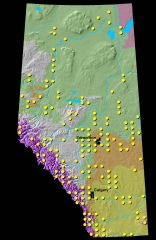Early Blue Violet
Viola adunca – Early blue violet leaves are very high in Vitamins A and C, with 1/4 cups of these leaves having about the same amount of Vitamin C as 4 oranges. It’s best not to destroy wild plants for food, but these violets grow easily in gardens and even multiply there, thanks to ants.
Other names
-
in Latin: Viola adunca J.E. Smith
-
in English: western long-spurred violet
-
in French: violette à éperon crochu
Taxonomy
Violet Family (Violaceae)
Description
A small wildflower (herb) that grows 4 cm to 10 cm tall.
-
Leaves: Leaves are I cm to 3 cm wide, heart- to kidney-shaped, and are attached along the flower stem.
-
Flowers: Fragrant, bluish-purple flowers are up to 2 cm across. There are purple lines on the three lower petals and white ‘beards’ on the two side petals.
-
Fruit: A dry, 3-valved, many-seeded capsule.
Distribution
Widespread throughout Alberta.
Habitat
Early blue violet plants grow in open woods and prairie.
How to Observe
-
If the plants are very abundant, mark a plot about one metre by one metre in size.
-
Record these dates:
-
First bloom: When the first flowers are open in the plant, or patch observed.
- Mid bloom: When approximately half (50%) of the flowers on the plants under observation are open.
When does this plant flower?
It usually flowers in mid to late May.
Life Cycle
Many violets produce 2 types of flowers. In the spring and early summer, their showy blooms (the ones we observe for Plantwatch) appear. However, only a few of these are fertilized each year. If no seed is produced, apomyxis, or self-fertilization occurs.
The plant produces much smaller (“blind”) flowers in the fall. These blooms are seldom seen as they are hidden away among the leaves, at or below ground level. Their petals are reduced to tiny scales and their flower parts are reduced in size and number. They have no scent and they never open. These flowers fertilize themselves and produce an abundance of seed, which are normal in appearance, but tend to develop more quickly than seeds produced by cross-pollination.
When violet seed capsules mature, the seeds are explosively shot out to several centimeters away from the parent plant.
Ecology
Violet seeds have special oily bodies called elaiosomes (think of them as potato chips!) . These delicious snacks attract ants, which carry them to their nests, thus dispersing the seeds further. Once the ‘snack’ is removed from the seed, the seed is ready to germinate in the loose, open soil around the anthill.
Flowers called “cleistogamics” or blind flowers were first discovered on violets. The showy violet flowers that do not open share genes by cross-pollination and produce hardier plants.
Phenology
Flowers usually appear in mid to late May in Alberta.
Human Uses
Other than seeds and rhizomes, the entire early blue violet plant is edible. Leaves can be used in salads and to make tea, and candied violet flowers can be used as garnish for desserts. Violet vinegar can be made by adding blossoms to white wine vinegar. The leaves are very high in Vitamins A and C, with 1 ¼ cups of early blue violet leaves having about the same amount of Vitamin C as 4 oranges. In parts of the United States, violets are called wild okra and are often used to thicken soups.
Warning: some violet leaves (other species?) contain saponin, which can upset the digestion if large amounts are used. Avoid roots, fruits and seeds, which contain toxins.
Medicinally, early blue violet was used as a poultice for bruises, and a violet syrup was made to relieve epilepsy, inflamed eyes, insomnia, jaundice, an sore throats. In modern times, violets have been used to colour and flavour medicines.
Blackfoot Indians used the blue colour to dye arrows.
Violets often appear in ancient artwork and poetry. Mohammed loved the violet, as did Napoleon and the violet became the emblem of the Bonapartists.
Horticulture (Use in the Garden)
This plant grows easily in the garden from seed.
Quotes
The violet in her greenwood bower,
Where birchen boughs with hazel mingle,
May boast herself the fairest flower
In forest glade or corpsewood dingle.
-Scott
References
Brown, A. 1970. Old Man’s Garden. 2nd edition. Evergreen Press Ltd. Sydney, British Columbia.
Cormack, R. G. G. 1977. Wildflowers of Alberta. Hurtig Publishers. Edmonton, Alberta.
Johnson, D. et. al. 1995. Plants of the Western Boreal Forest and Aspen Parkland. Lone Pine Publishing. Edmonton, Alberta.
Moss, E. H. 1983. Flora of Alberta. 2nd edition. University of Toronto Press. Toronto, Ontario.
Wilkinson, K. 1999. Wildflowers of Alberta: A Guide to Common Wildflowers and Other Herbaceous Plants. University of Alberta Press and Lone Pine Publishing. Edmonton, Alberta.





